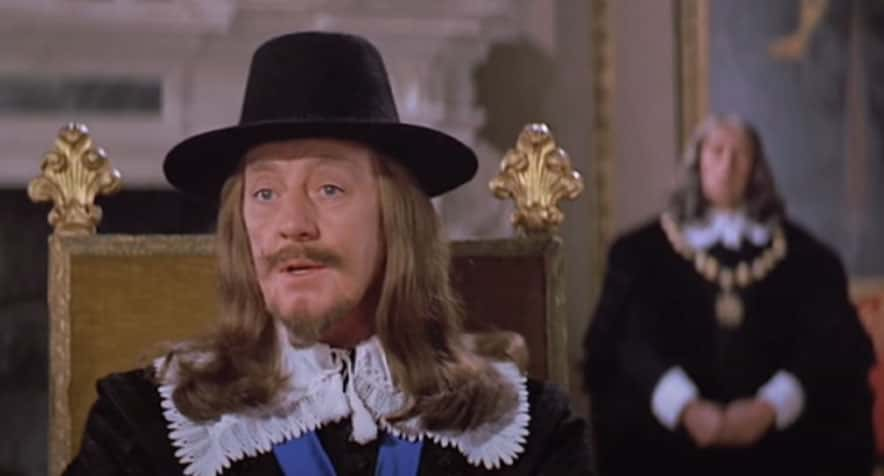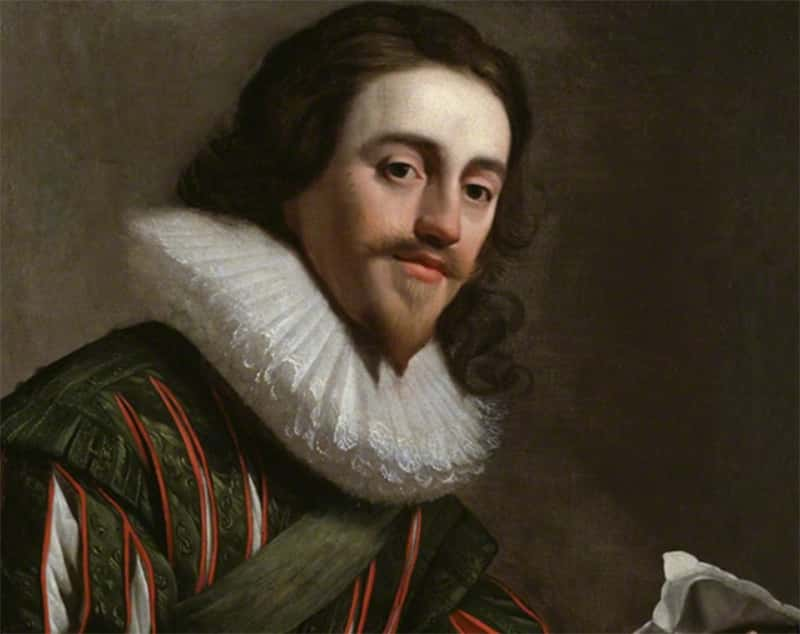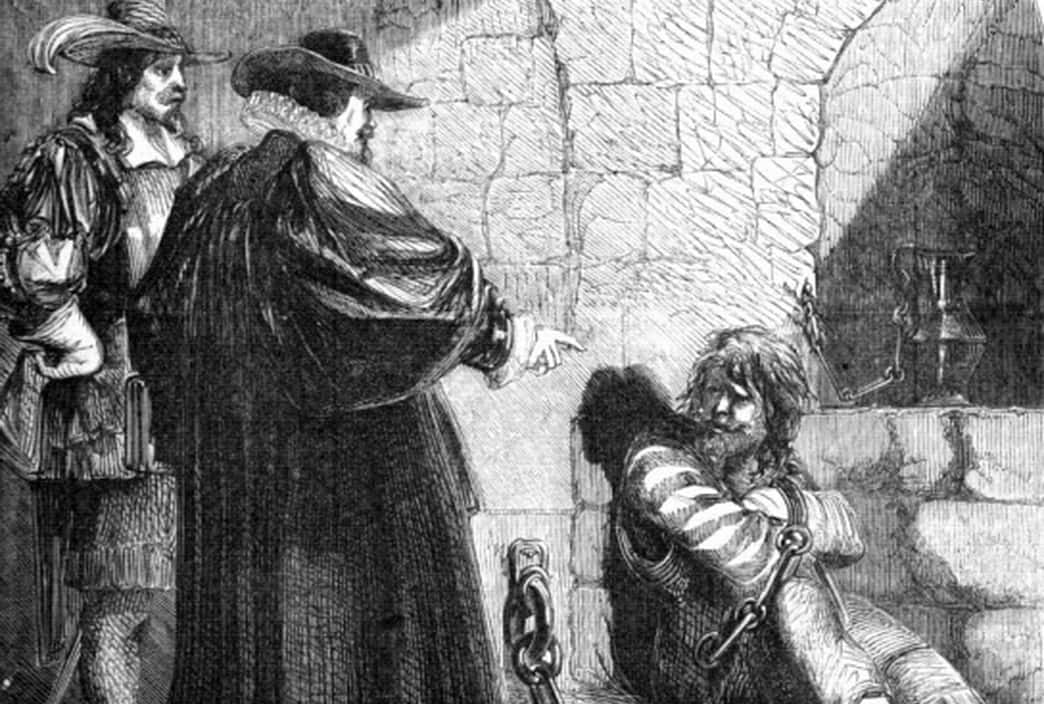George Villiers, The King’s Lover
Every once in a while, someone comes along to make history a whole lot more interesting. In this category, few people can hold a candle to George Villiers, the 1st Duke of Buckingham. Villiers held a special place in the King of England’s heart—maybe a little bit too special, because he almost brought the entire country down around him!
From crazy scandals to bizarre antics to shocking secrets, here are 50 facts about the king's lover, George Villiers.

1. His Parents Were Cousins
Yep, you read that right. As icky as it may sound to our modern sensibilities, George Villiers’ parents were indeed cousins and few considered it a big deal at the time. Regardless, they had four children together before the family patriarch passed, leaving young George and his siblings to be solely raised by their mother, Mary.

2. His Mother Pushed Him Into The Courtier Lifestyle
Mary always felt that her son had extraordinary talent and was destined for an important political role. Although she had little money, she wanted to give George a proper high-class education to prepare him for life as a courtier. As a result, she sent the young lad off to the French Court—but don't worry, he didn't go alone.
3. His Friend Became Famous
Though the public did not yet know their names, the teenage traveling buddies would prove to be a duo for the history books. The young Villiers’ partner-in-crime, John Eliot, grew up to be an influential statesman famous for his support of the rights of Parliament—an opinion for which he was repeatedly imprisoned as an adult.
But of the two, Villiers would make the biggest splash by far.
4. He Had Many Talents
George Villiers was an exceptionally talented student and excelled in his new educational setting. In addition to being a model pupil academically, he was an excellent dancer, fencer, and French speaker. Before long, he also mastered the skills of courtly behavior and developed an appropriate wardrobe for the segments of society he hoped to join.
Basically, Villiers was hot stuff. It was only a matter of time before someone important noticed him.
5. He Received High Praise From Unexpected Places
We all love compliments, but it’s hard to beat the one that Villiers received from Godfrey Goodman, the Bishop of Gloucester, during his youth. The Bishop described George Villiers as the "handsomest-bodied man in all of England". He also declared "his limbs so well-compacted," "his conversation so pleasing," and his general disposition "so sweet".
Perhaps this was a sign of things to come...
6. He Turned An Important Head
Almost immediately upon his arrival to the English court, Villiers made an impact. At the young age of 21, he caught the attention of King James I. The King took a very strong liking to him from the moment they first met during a hunt in the Northamptonshire village of Apethorpe. Things were about to get interesting...
7. He Seemed Well-Suited For A Special Role
In order to understand why James would have had such an interest in the lad, there are two facts that need to be understood. Firstly, there was an official position in the royal social structure called the King’s "favorite"—the ruler’s most intimate companion. At the time when James and Villiers met, the incumbent favorite, Robert Carr, had been facing some serious drama and was walking on thin ice.
8. "Favorite" Meant More Than A Political Role With James
The second thing you need to know about the situation is that, despite the fact that James had a wife and family, he also liked to sleep with men on the side—his then-favorite, Robert Carr, had also been his regular lover. If this already sounds like a scandalous situation, you won’t believe what happened next…
9. Scandal Hit The Royal Palace
Despite having everything in the world available to him as the King’s favorite, Robert Carr screwed up—badly. He became interested in another man’s wife and, when a fight between the two men broke out over it, Carr took the other man's life. When he faced punishment and the scandal became public, the whole mess left the king humiliated.
His opinion began to sour on Carr, opening the door for someone else to take his place…
10. Villiers Posed An Opportunity
Many people in the King’s inner circle hated Robert Carr and desperately wanted to see him replaced as favorite. With Carr in trouble and with the King taking a liking to Villiers, Carr’s detractors saw a golden opportunity to try and bring about some changes in the palace. George Villiers made the perfect political pawn to help these folks to get their way.
They had no way of knowing it at the time, but they were creating a monster.
11. They Mobilized On His Behalf
Those who wanted to see Carr ousted launched an all-out effort to entice James into replacing him with Villiers. People raised money to buy Villiers a whole new wardrobe. They arranged for Villiers to dance publicly on a frequent basis. Finally, a lobbying effort succeeded in getting Villiers appointed as Royal Cupbearer so that he could frequently converse with the King.
 The Three Musketeers (2011), Constantin Film
The Three Musketeers (2011), Constantin Film
12. The Plan Worked
Not only did Villiers soon become the new favorite, but the King also bestowed a whole host of new titles and honors onto him. The peak of these honors came in 1623, when James appointed him the new Duke of Buckingham. At the time, this dukedom had been nonexistent for a century. The King reestablished it specifically to give the position to Villiers.
In what felt like a blink of an eye, the one-time nobody George Villiers was suddenly a huge deal.
13. His Appointment Made History
The elevation of George Villiers to the role of Duke of Buckingham was absolutely shocking, and not just for its role in his personal relationship with the King. The appointment marked the first instance in more than a century in which a King elevated a commoner to a dukedom. James was clearly smitten with his new favorite—but he never could have imagined what a mistake he was making.
14. He Had Friends In High Places
Interestingly enough, George Villiers already had a connection with the royal family even before becoming the King’s favorite. During his school days, he had been peers with James’ son, Prince Charles. Not only that, but Villiers had even been the Prince’s personal dance tutor at one point. This made Villiers’ arrival to the palace a reunion of sorts, even though it also marked the start of a whole new life for him.
15. James Really Liked Villiers
James wasted no time in turning his new favorite into his new lover. He even gave Villiers a nickname. He affectionately called him "Steenie" in honor of St. Stephen, a figure who people remembered as having had "the face of an angel". That’s right. The King of England gave a Duke a cutesy nickname like some lovestruck teenager. Things really have a way of defying stereotypes, don’t they?
16. Villiers Had A Tough Act To Follow
As passionately as James loved Villiers, he was far from the King’s first male lover. Even before the aforementioned Carr, James had a wild relationship with a man named Esmé Stewart. Stewart had even converted to the King’s religion to keep him happy. There must have been a lot of pressure on Villiers knowing that he had to live up to expectations of that magnitude...
17. He Went All In
Over time, James’ love for Villiers developed into something on a whole other level. The King called him his "sweet child and wife" and made it clear to everyone that he loved him more than anything in the world. While describing the relationship to his advisors, the King compared himself to Christ and invoked the story of the beloved disciple John as an analogy.
18. The Queen Had No Problem With Any Of This
So what exactly did the King’s wife think of her husband’s full-blown love affair with some random young man? Turns out she actually felt kinda cool with it. She became good friends with Villiers and even wrote him letters urging him to remain "always true" to her husband. I’ve heard of standing by your man, but this seems like a little much…
19. This Story Has An Ironic Twist
Given the fact that some religious extremists today cite the Bible to argue that gay relationships are sinful, you may be surprised to learn that the King James who had the steamy affair with George Villiers is the very same King James who oversaw the creation of globally used, standard "King James" edition of the Bible. It just goes to show that things are never quite as black and white as they seem!
20. Some Doubt The Details
Despite the popular narrative of the relationship between Villiers and James and the evidence that supports it, there are some historians out there who believe that the couple never actually consummated their love physically. They point to the fact that the King’s contemporary rivals did not accuse him of sleeping with his favorite—though others did in fact make such claims.
21. The King Let Him Do Whatever He Wanted
Regardless of the doubts some may have, one thing is definitely clear: James loved Villiers enough to allow him tremendous influence over the kingdom. Over time, Villiers began to take advantage of his unique position in increasingly bizarre and inappropriate ways—and the crazier his actions became, the more the public started to hate him.
22. He Gave The World A Legend
George Villiers met and befriended the famous philosopher Sir Francis Bacon. The pair became pretty close and Villiers even helped advance Bacon's career, using his power to support Bacon's appointment as Lord Chancellor. But what started out as a cool connection between two historical figures would soon take a sketchy turn…
23. He Took Advantage Of His Power
Little by little, Villiers began using his power to enrich himself, his family, and his friends. He accepted bribes and inappropriate gifts, misused public funds for his own lavish desires, and tried to create monopolies wherever it would benefit him to do so. He even got his old friend Sir Francis Bacon mixed up in his misadventures—and the fallout was devastating.
 The Three Musketeers (2011), Constantin Film
The Three Musketeers (2011), Constantin Film
24. He Got His Famous Friend Into Trouble
Since Villiers had helped Bacon receive his official position, the Duke took advantage of his grateful attitude. He repeatedly demanded that the philosopher grant favors to his allies via his position as Lord Chancellor. Parliament eventually caught on to what was happening and forced Bacon to retire over the corruption scandal. And did Villiers stick up for his buddy? Nope! He kept silent and did nothing to prevent his friend from facing punishment.
By this time, despite the fact that James was technically king, people were referring to Villiers as the "unchallenged ruler of England".
25. He Weaseled His Way Out Of Trouble
When Parliament decided to thoroughly investigate issues such as corruption and monopolies, George Villiers realized he could be facing a lot of trouble in the near future. So, after putting on a fake show of support for the investigation, he intentionally caused a rift between lawmakers over an important foreign policy issue. This manipulative tactic worked to the tee.
Parliament dissolved early and the investigation fell completely by the wayside. Villiers got off scot-free—but how long could he keep this up for?
26. He Became A Showoff
In one of his many bizarre and manipulative habits, Villiers often used art as a means of self-promotion. He held many festive events in which he would dance and perform, keeping the attention centered on himself at all times. He also commissioned multiple paintings of himself, all of which surely stroked his ego.
27. He Also Had A Private Life
Despite his questionable escapades and his relationship with the King, Villiers still somehow found time on the side to have a family. He married the daughter of an Earl in 1620, even though her father did not approve of the idea. The couple had four children together, including one who would follow in his father’s footsteps and become the Second Duke of Buckingham.
28. He Cost The Prince A Wife
When the king's son, Prince Charles, headed to Spain to find a wife for himself, he brought George Villiers along to help with the negotiations. Unfortunately, this turned out to be a horrible move. Despite the sensitive nature of the subject matter that they were discussing, Villiers reportedly acted atrociously towards the Spanish dignitaries—causing the potential marriage agreement to go up in smoke.
29. His Behavior Had Consequences
The collapse of Charles’ marriage negotiations in Spain mattered, and not just because the Prince wanted a companion. James had planned for his son to marry a Spanish dignitary in order to secure a strategic alliance with Spain. When Villiers’ behavior caused the plan to fall apart, Spain did not take it lightly. They actually asked the British Parliament to have Villiers executed over the incident!
30. He Turned The Tables In A Dangerous Way
Despite the political firestorm caused by Villiers’ bumbling over the Spanish match, his expert manipulation tactics saved his hide once again. Immediately upon his return to England, Villiers publicly presented the Spanish as the ones responsible for the incident and called for war against them—riling the patriotic public up to support him.
 The Three Musketeers (2011), Constantin Film
The Three Musketeers (2011), Constantin Film
31. He Oversaw A Controversial Choice
More controversy erupted when, the following year, marriage negotiations resumed and Villiers again went along and influenced things. In the end, Henrietta Maria of France became the bride chosen for Charles. This decision angered the British public, who did not support Maria’s Catholic faith. Once again, the masses found yet new reasons to hate George Villiers' guts.
32. He Caught A Lucky Break
The life of King James came to an end in 1625, as did Villiers’ tenure as favorite. However, as luck would have it, his old friend, the new King Charles I, inherited the throne and decided to keep him around. From this point on, as the trusted Lord Admiral, Villiers became the kingdom’s de facto Foreign Minister. Not one other member of King James’ court managed to keep their positions under Charles.
Bizarrely, Charles seemed just as devoted to Villiers as his father had—maybe even more so!
33. He Took Over A Major Institution
Early on in the reign of King Charles, Villiers received yet another prestigious position that left many folks scratching their heads. Thanks to the support of the king, who wanted allies in as many powerful societal posts as possible, Villiers briefly served as Chancellor of Cambridge University when the previous Chancellor passed in 1626.
Was he qualified? Of course not. Did either of them care? Not a bit!
34. He Won A Super Shady Election
Many questioned Villiers’ qualifications for running a prestigious university, but some also questioned whether he cheated in order to receive the position. The other candidate for the job had been the son of the recently deceased previous chancellor, and Villiers won the election by just three votes. People in the room during the vote reportedly doubted its validity. But, with the King on George’s side, they had no way to stop it.
 Cromwell (1970), Columbia Pictures
Cromwell (1970), Columbia Pictures
35. He Tried To Use Conflict For Personal Gain
Villiers had a terrible public reputation and wanted to fix it. So, to quell anger over the Catholic bride he helped pick for Charles, he got his country involved in a violent religious conflict in France—backing the Protestant-aligned forces. This turned out to be a disaster for everyone involved, but, then again, when has entering a religious conflict for personal gain ever ended well?
36. He Sucked As A Leader
A series of major blunders and setbacks took place on Villiers’ watch during this conflict. From failing to achieve strategic objectives, to failing to properly equip soldiers for their battles, to accidentally tipping off enemies about tactics, it seemed like every single combat operation in which Villiers played a role ended in catastrophe for England.
Entering France seemed like a bad idea to begin with—but it ended up going so much worse than anyone could have imagined.
37. They Cut Off His Funding
As if the public did not hate Villiers enough already, they viewed him as a total pariah following his failures in battle. Pretty soon, members of Parliament began to feel the same way. They started to deny his requests for more funds and taxes, meaning he could no longer pay for his wars or for his controversial personal expenses. Looks like his lifetime of favoritism and privilege was finally starting to catch up with him.
 Cromwell ,Columbia Pictures Corporation
Cromwell ,Columbia Pictures Corporation
38. He Ran Out Of Money
With Parliament restricting his access to public money, things quickly went from bad to worse for Villiers. He became totally bankrupt and had to find new and creative ways of fundraising in order to keep the fighting going. He even paid for some of the expenses out of his own pocket (gasp) and made himself personally liable for paying off debts to several of his officers.
39. His Poor Finances Got The King In Trouble
In case you couldn’t see this coming, Villiers could not manage to pay off his personal debts to the officers when they came around to collect. After waiting patiently for a full 10 months to receive the money he owed them, they finally had enough and did something shocking. A whole group of them looted the stores of the king himself to get what they were owed!
All of a sudden, England seemed like a ticking time bomb—and it was only a matter of time before it exploded.
 Cromwell (1970), Columbia Pictures
Cromwell (1970), Columbia Pictures
40. Parliament Had Enough Of Him
Parliament could only take so much of Villiers’ nonsense. In May 1626, they finally decided to try and get rid of him. They tried to impeach him not once, but twice. However, on both occasions, King Charles came to the rescue and dissolved Parliament before they could complete the process of tossing him out. Charles stuck by his man—but he'd end up paying the ultimate price for it.
41. They Took His Doctor’s Life
The amount of public hatred against Villiers reached an all-time high—and it took some very ugly turns. At one point, an angry mob attacked Villiers’ doctor as he walked the streets of London. The attack was so vicious, he succumbed to his wounds soon after. The mob targeted him due to a strange conspiracy theory that he had been practicing black magic and using it to influence Villiers’ bad behavior.
 The Three Musketeers (2011), Constantin Film
The Three Musketeers (2011), Constantin Film
42. Things Ended In A Tragic Fashion
After a lifetime of making headlines for ridiculous reasons, the last headlines Villers made were the darkest of all. While at the Greyhound Pub in Portsmouth in August 1628, an assailant violently attacked him with a knife. Despite his wounds, the Duke attempted to chase after his attacker—but fate had other plans. George Villiers, 1st Duke of Buckingham, collapsed and bled out on the spot.
43. The Attacker Had Many Reasons
John Felton is the name of the assailant who took Villiers’ life. A former sailor, he served in one of Villiers' failed conflicts and suffered a terrible wound while doing it. Unsurprisingly, he absolutely hated the Duke. For a little more motivation, Felton also felt that Villiers had snubbed him for a promotion at one point. In his mind, getting rid of the controversial figure not only achieved personal revenge, but served the public interest. Can't say the people of England would have disagreed!
44. The Tragedy Made The Public Happy
Unlike your typical political assassination, this one did not lead to a period of mass mourning and sorrow. On the contrary, the public celebrated Felton as a national hero. A number of popular poems went around that celebrated Felton and praised what he had done, which they viewed as completely justified.
45. The Government Came Down Hard Against The Haters
Crazy incidents took place where the King’s government tried to stop the public celebration of Villiers’ passing. On one occasion, they caught the son of a well-known scholar making a toast that praised Felton and criticized the monarchy. Charles slapped him with a massive fine—OK, not so bad—and ordered his ears to be cut off.
 Cromwell (1970), Columbia Pictures
Cromwell (1970), Columbia Pictures
46. They Failed To Change Public Opinion
When the government hanged Felton for what he did to Villiers, they decided that displaying his body publicly would deter the masses from continuing to disrespect the King and his supporters. This quickly proved to be another mistake. His body almost immediately became a major attraction for the public to visit and venerate. I guess no one had understood the full extent of how much the people hated Villiers!
47. His Grave Suits His Personality
They buried Villiers in Westminster Abbey alongside the monarchs he served. Appropriate for the way he lived his life, the tomb is lavishly decorated and includes a depiction of the Duke decked out in fancy attire. It also includes an inscription in Latin that translates to "Enigma of the World". Can you think of a more fitting final resting place for a guy like Villiers than that?
48. Charles Joined Him Soon Enough
So, after Villiers was gone, did the people of England finally forgive King Charles and let bygones be bygones? Not by a long shot. Even without Villiers around to screw everything up, Charles remained a terrible king. Eventually, the people of England got fed up enough to do the unthinkable: They captured Charles, tried him for treason, and beheaded him.
To this day, he's the only English monarch to be toppled by his own people.
 Cromwell (1970), Columbia Pictures
Cromwell (1970), Columbia Pictures
49. He Still Gets Attention
Fictionalized versions of Villiers have appeared in countless works of literature over the years, including examples from many different genres and media. Examples range from 1844’s classic The Three Musketeers to a 2002 adaptation of Doctor Who. You know you’re important when things that different from one another all have an interest in you!
 The Three Musketeers (2011), Constantin Film
The Three Musketeers (2011), Constantin Film
50. His Son Got His Name Everywhere
Developers eventually purchased the location of Villiers’ home from his son in order to create London’s Adelphi district. However, in the typical grandiose fashion that made the late Duke famous, his son insisted that all of the neighborhood’s new streets be named after Villiers. As a result, they called five streets in the area "George Court," "Villiers Street," "Duke Street," "Of Alley," and "Buckingham Street".
Sources: 1, 2, 3, 4, 5, 6, 7, 8, 9, 10, 11, 12, 13, 14, 15, 16, 17, 18

















































